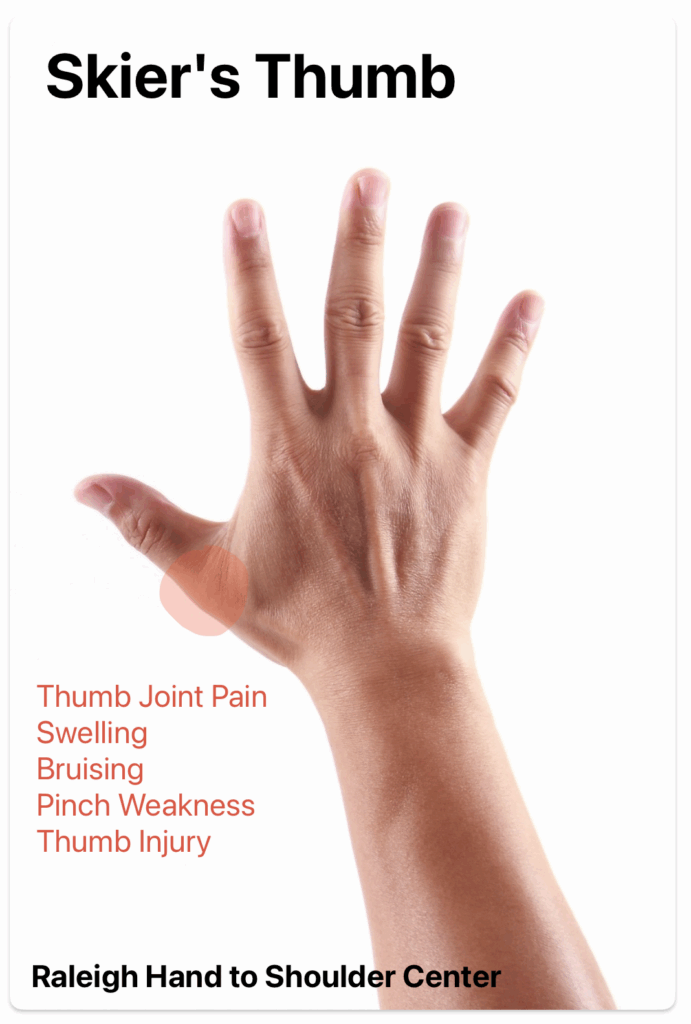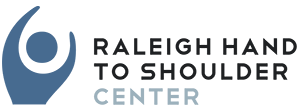The Raleigh Hand to Shoulder Center physicians have treated patients with hand and arm problems…
What is a Skier’s Thumb?
A “skier’s thumb” is a common injury to the hand, resulting in a tear of an important ligament in the thumb. This injury often occurs when the thumb is bent backwards during a fall on an outstretched hand. It is called a “skier’s thumb” because of how often it occurs on the ski slopes, especially when falling on the hand while holding a ski pole.
Of course not just skiers get a “skier’s thumb.” This injury is common in other sports or in someone who falls on an outstretched hand. When an injury to the thumb ligament occurs after chronic, repetitive trauma, it can be referred to as a “gamekeeper’s thumb.” This older term is in honor of the Scottish gamekeepers who often developed this thumb condition.

A skier’s thumb involves an injury to the ulnar collateral ligament (UCL) of the thumb metacarpophalangeal (MP) joint. The thumb UCL is an important stabilizing ligament, and allows us to pinch with the thumb with strength and precision. Without an intact ulnar collateral ligament, pinching with the thumb can be weak and painful. Opening jars, turning keys, and even light tasks can be difficult without a healthy thumb. The risk of degenerative joint disease (osteoarthritis) is also increased when a joint is unstable or the ligament is injured chronically.
How do I know if I have a skier’s thumb?
The diagnosis is made based primarily on history, physical exam, and x-rays. Most patients recall a sudden injury to the thumb associated with pain, swelling, and possible bruising around the joint. Afterwards patients notice pain and weakness with pinching tasks and limited thumb range of motion. The physical exam includes evaluation of the joint stability and possible injuries to the bones, joints, tendons, and other important structures in the thumb and hand. X-rays are helpful to rule-out a fracture of the thumb. Stress x-rays can be obtained in the clinic if the joint stability is not clear on the physical exam. Occasionally, ultrasound imaging or an MRI can be helpful to evaluate this condition.
What are the treatments for skier’s thumb?
The treatment plan for a skier’s thumb will depend on the severity of the injury as well as the patient’s medical conditions and activity level. Injury severity ranges from a minor sprain to a full-thickness tear of the ligament. This has been classified into 3 grades: grade I is a minor sprain of the thumb UCL; grade II is a partial tear of the UCL; grade III is a full-thickness tear with joint instability. Most people have sprains or partial tears of the UCL (grade I or II). If the joint is stable on examination, surgery is not usually required. Treatment in these cases is typically rest and protection in a cast or full-time brace for about 6 weeks. Activities are resumed as comfort permits, but forceful pinching is discouraged for about 2-3 months from the injury. It is very common to have some swelling and “aching” pain in the thumb for 6 months after the injury, particularly during strenuous hand activities.
When a full-thickness tear of the thumb UCL occurs (grade III injury), surgery is usually recommended. This is because in most grade III injuries, the ligament detaches from the bone and causes the thumb joint to be unstable. The UCL cannot heal properly when it is displaced too far from its natural healing position or it is blocked by nearby soft tissue structures.
Skier’s Thumb Surgery
Skier’s thumb repair surgery is performed as an outpatient usually at our surgery center with the patient under sedation anesthesia. The surgeon will make an incision at the thumb MP joint, identify the damaged structures, and perform a repair of the injured UCL ligament. In most cases, a bone anchor is used to secure the ligament back to the bone. Sometimes a temporary pin is placed across the joint to protect the repair.
If there has been a long delay in diagnosis it may be more difficult to repair the injured thumb UCL. In these chronic cases, the surgeon may need to have a back-up plan in order to repair the ligament: a tendon graft may be needed to reconstruct the UCL or the surgeon may use an implant such as an internal brace to augment the repair.
What is the recovery after skier’s thumb repair surgery?
After surgery, the patient’s thumb and wrist will be protected in a plaster splint for about 2 weeks. At this point, most patients are placed into a custom-made splint or cast for an additional 4 to 6 weeks. Hand therapy is usually helpful during the healing process to reduce scar tissue, improve thumb range of motion, and improve hand strength. Most surgeons recommend avoiding heavy hand use for approximately 3 months after surgery. The ligament repair site requires several weeks to heal adequately. Unadvised use of the thumb before this time could compromise the healing.
Most patients can return to better function at about 3 months post-operatively, but maximum improvement can take 6 months or so. Occasionally, patients have residual stiffness and “aching” in the thumb joint after treatment. Arthritis, also known as degenerative joint disease, may develop in the future if the initial injury damaged the joint surface.
Our goal at the Raleigh Hand to Shoulder Center is to help each patient obtain the best function possible after their skier’s thumb injury. The doctors are board certified and members of the American Society for Surgery of the Hand.


